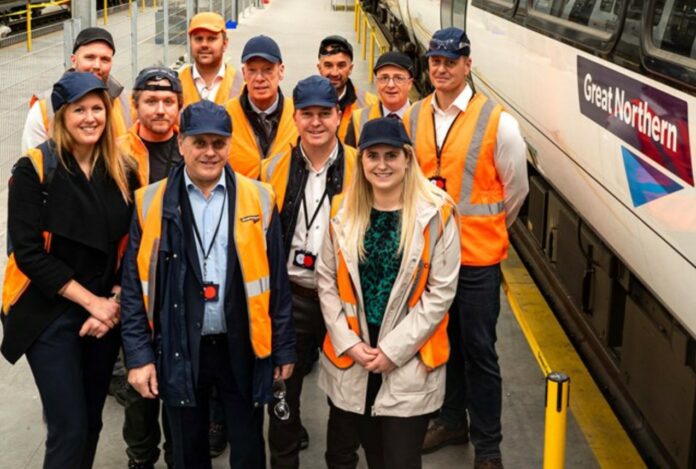Govia Thameslink Railway’s (GTR’s) first Class 387/1 Great Northern Electrostar train has now completed static testing of its retrofitted European Train Control Signalling (ETCS) in-cab signalling equipment, as part of the East Coast Digital Programme, aimed at improving performance for passengers, while reducing emissions.
The Class 387 is the country’s first major commuter fleet to have the technology retrofitted, and it lays the foundations for the digital upgrade to be applied to the rest of the UK’s vast Electrostar fleet, for future expansion of ETCS across other routes.
Unit 387101’s recently retrofitted onboard ETCS system (Atlas 3) was commissioned at Alstom’s Litchurch Lane manufacturing site in Derby where each new piece of equipment went through powered-up electrical testing. Alstom also carried out low-speed dynamic testing of the Eurobalise antenna and odometry system, which detect the train’s location.
On 23 May, the train was hauled by GBRf from Litchurch Lane to the Rail Innovation and Development Centre (RIDC) in Melton Mowbray (see picture below), where dynamic testing of the ETCS odometry equipment will commence, expected to take approximately three weeks.
This is the first of three dynamic testing events for Unit 387101 at RIDIC; all three tests are expected to have been completed by October 2023.
This ‘first-in-class’ train is set to return in November 2023, after which GTR will fit the remaining 28 387/1 units at its in-house depot in Hornsey, north London.
GTR’s ERTMS Fleet Project Manager Aaron Meakin said: “We’re delighted with how the newly retrofitted ETCS system has performed on our Class 387 train in static testing. It bodes well as we move into dynamic testing at RIDC. Our engineering team and the team at Alstom are working closely together to ensure success and we’re looking forward to continuing this collaboration.”
Aaron Weeks, Project Director for Alstom said: “The Class 387 is the first unit in the UK to utilise the newest generation of Alstom’s ETCS Onboard signalling product, known as ATLAS 3. We are delighted to successfully complete the fitment and static testing and now we are looking forward to dynamically testing the train at RIDC in the coming months.
“Alstom recognises that the digitisation of the UK rail network needs new ways of innovative cross industry working and the ongoing close collaboration between our team and partners at GTR, Porterbrook and Network Rail on this project is a great example of this.”
The Government-funded East Coast Digital Programme will see traditional signals removed from the tracks on the Northern City Line to London Moorgate and the East Coast Mainline from London to Stoke Tunnels, south of Grantham. They will be replaced with state-of-the-art digital signalling technology. This will improve reliability, meaning a better performing rail service for customers using this key route.
In-cab signalling provided by ETCS Level 2 operation supplies continual speed information and movement authority to the driver via a computer screen in the driver’s cab, rather than relying on fixed lineside signals.
Ed Akers, Network Rail’s Principal Programme Sponsor, East Coast Digital Programme, said: “This is another important step forward in the largest passenger fleet retrofitting project in the ECDP. We’ve got here because of pioneering collaboration across multiple industry partners. The partnership working will continue as the train gets put through its paces at our upgraded facilities at RIDC, preparing the way for its use with digitally signalled passenger services.”
Ben Ackroyd, Chief Operating Officer at Porterbrook, which owns GTR’s Class 387 fleet said: “Successful completion of static testing signals an important milestone in this project aimed at improving performance and reliability for passengers. We’re proud to be playing our part in this industry partnership and look forward to continued collaboration as the ‘first-in-class’ train moves into dynamic testing.”
Photo credit: GTR







































 0113 2082620
0113 2082620 info@railbusinessdaily.com
info@railbusinessdaily.com 15 Mariner Court, Wakefield WF4 3FL
15 Mariner Court, Wakefield WF4 3FL

